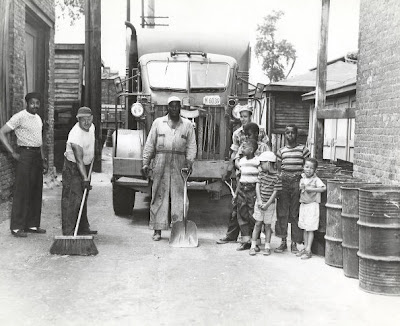View Jane Addams Hull-House Museum in a larger map
Visit our Tour Destination: Illinois page to see the entire tour of the state’s
Save America’s Treasures sites.
 |
| Jane Addams Hull-House Museum. Photo courtesy of Jane Addams Hull-House Museum. |
The University of Illinois at Chicago
800 S. Halsted
Website: Jane Addams Hull-House Museum
The Treasure: Hull-House
was America ’s
most famous settlement house—a place where the ideals of the Progressive Era
were put into practice, improving the lives of thousands.
Accessibility: The
museum is open Tuesday through Fridays from 10 to 4 and Sunday from noon to
4. It’s closed Mondays and Saturdays.
 |
| Jane Addams. Image from Hull-House Yearbooks, courtesy of University of Illinois at Chicago Library. |
Background: Jane
Addams took the ideals of the Progressive Era and put them into practice.
Hull-House, a settlement house co-founded by Addams and Ellen Gates Starr in
1889, was her incubator. Through a wide array of programs and activities,
Addams and Starr endeavored to improve the lives of the residents of some of Chicago ’s poorest
neighborhoods. They fought for better urban living conditions, while
creating a safe environment where disadvantaged people could benefit from the
free offering of arts, culture, and education.
A reformist social movement that began in London in the middle of the 19th century, the settlement movement sought to bring
the upper class and the lower class together in environments of mutual
respect. Largely driven by the idealistic concerns of upper-middle-class
and upper-class women, the settlement movement was extremely flexible, ready to
engage in social work, cultural and art activities, recreational programs, and
education. Hull-House was not the first American settlement house, but
thanks to the drive of Addams and Starr it quickly became a beacon of the
movement in the United
States .
Known as “residents,” the volunteers who worked at
Hull-House offered a buzzing environment of classes, concerts, lectures,
theater, and training programs. They served a local community that was a
complex maze of small ethnic neighborhoods. Initially, they primarily worked with
Italians, Irish, Germans, Greeks, Bohemians, and Russian and Polish Jewish
immigrants. As immigration and migration patterns began to change the
makeup of the neighborhoods, Hull-House reached out to
Mexican-American and African-American families, as well. It was always the
working poor that were the focus of Hull-House—the people who worked long hours
as unskilled laborers at the garment industry sweatshops and the factories
along the Chicago River .
 |
| At the Front Door of Hull House. Historic photo from Hull-House Yearbooks, courtesy of University of Illinois at Chicago Library. |
In the city’s poorest sections, sanitation was poor, wages
were low, and young children were recruited for some of the dirtiest and most
dangerous jobs. Hull-House was on the forefront of advocating for
improved government services and tougher industry regulations. Hull-House offered an oasis where families could imagine a better future.
Jane Addams wrote, “To feed the mind of the worker, to lift it above the
monotony of his task and connect it with the larger world, outside of his
immediate surroundings, has always been the object of art.” Following her vision, Addams organized and promoted art
classes and training programs to unleash creativity and tap latent talents.
Today, the Jane B. Addams Hull-House Museum
is an historic site that tells the story of America ’s most famous settlement
house. Exhibits explore the lives of neighborhood children, the
commitment of the residents who worked at Hull-House, artwork by Chicago
artists who trained and taught at Hull-House, historical photographs of the
neighborhood, and the restored bedroom of Jane Addams, where you can see her
1931 Nobel Peace Prize, the first ever given to an American woman.
But the real story of Hull-House lies in the thousands of
changed and transformed lives that passed through it. One exhibit
explores two of those lives: Hilda Satt Polachek and Jesús Torres.
Born in Poland , Polachek
immigrated to the United States
and Chicago
when just a little girl. At the age of 18, she began attending courses at
Hull-House and discovered a talent for writing. Her memoir of her time at
Hull-House, I Came a Stranger:
The Story of a Hull-House Girl, was published posthumously in 1989
and is one of the best windows into life inside a settlement house. A
Mexican migrant, Jesús Torres learned ceramics at the Hull-House Kilns,
receiving instruction from Russian immigrant artist Morris Topchevksy in the
1930s. Thanks to his Hull-House training, Torres became a successful and
widely admired ceramic artist, doing much work with Chicago ’s Carl Street Studios.
 |
| The oldest known photograph of Hull-House. Photo courtesy of Jane Addams Hull-House Museum. |
 |
| Hull-House at it looked in the 1920s. Photo courtesy of Jane Addams Hull-House Museum. |
Other Recommended
Sites: Many Mexicans came north in the 1920s, looking for work
at the Chicago
factories. They settled into
neighborhoods, bringing a vibrant culture and traditions with them. Fittingly, Chicago
is now home to the National Museum of Mexican Art located in Pilsen on the Lower West Side . The
museum showcases the beauty and richness of Mexican culture which has
flourished not just in the country of Mexico but throughout the Americas .
 |
| A painting of Hull-House that served as a basis for the 1960s restoration. Image courtesy of Jane Addams Hull-House Museum. |
Tour America's History Itinerary
Thursday’s destination: Feehan Library, Mundelein Seminary
© 2013 Lee Price

























